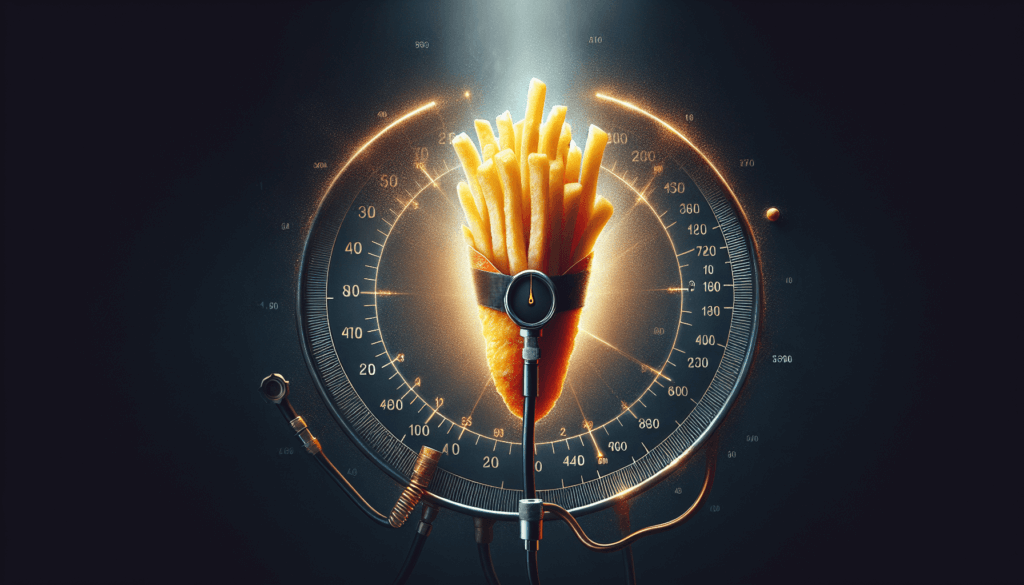Have you ever wondered if there is a connection between indulging in your favorite fried foods and the infamous high blood pressure? Well, the answer is not as straightforward as you might think. In this article, we will explore the relationship between consuming fried food and its potential impact on your blood pressure. So grab a seat, and let’s dig into this sizzling topic to find out the truth behind the myths.

Understanding High Blood Pressure
Definition of high blood pressure
High blood pressure, also known as hypertension, is a medical condition characterized by elevated levels of force exerted by blood against the walls of the arteries. It is typically measured in millimeters of mercury (mmHg) and recorded as two values – systolic pressure over diastolic pressure. Systolic pressure represents the force exerted when the heart contracts, while diastolic pressure represents the force when the heart is at rest between beats. A blood pressure reading above 130/80 mmHg is generally considered high and may indicate hypertension.
Causes of high blood pressure
There are various factors that can contribute to the development of high blood pressure. Some of the common causes include genetic predisposition, unhealthy lifestyle choices, obesity, excessive alcohol consumption, smoking, stress, and certain medical conditions such as kidney disease or hormonal disorders. Additionally, dietary factors, including the consumption of fried food, can also play a significant role in the development of hypertension.
The Link between Fried Food and High Blood Pressure
Effect of fried food consumption on blood pressure
Consuming fried food regularly has been shown to have a negative impact on blood pressure. Fried foods are typically high in unhealthy fats, calories, and sodium, all of which can contribute to the development of hypertension. When we consume fried foods, the unhealthy fats can increase the levels of bad cholesterol in our bodies, leading to the development of plaque buildup in the arteries. This, in turn, can cause the arteries to become narrower and less flexible, increasing blood pressure.
Role of fried food in developing hypertension
Fried foods are often cooked using oils that are high in saturated and trans fats, which are considered unhealthy fats. These fats can raise the levels of LDL cholesterol (bad cholesterol) in the body, leading to the formation of plaque in the arteries. The plaque buildup reduces the diameter of the arteries, making it harder for blood to flow through them. As a result, the heart has to pump harder to adequately circulate blood, causing an increase in blood pressure. Moreover, fried food is usually high in calories, which can contribute to weight gain, another risk factor for hypertension.
The Role of Sodium in Fried Food
Sodium content in fried food
One of the major contributors to high blood pressure in fried food is the high sodium content. Sodium is a mineral that is essential for our bodies, but excessive intake can have adverse effects, including increased blood pressure. Fried foods, especially fast food items, tend to have high sodium levels due to the added salt and seasoning used during the cooking process. The high sodium content can disrupt the delicate balance of fluids in the body and cause the blood vessels to constrict, leading to elevated blood pressure.
Effects of excessive sodium intake on blood pressure
When you consume excessive amounts of sodium, water retention can occur in your body. This leads to an increase in blood volume, which subsequently raises blood pressure. Additionally, the high sodium levels can directly affect the function of the kidneys, which regulate blood pressure. The kidneys play a crucial role in maintaining the balance of sodium and fluid levels in the body. Excessive sodium intake can disrupt this balance, leading to an increase in blood pressure.
Fried Food and Obesity
Relationship between obesity and high blood pressure
There is a strong correlation between obesity and high blood pressure. Obesity is defined as having an excessive amount of body fat, usually determined by a high body mass index (BMI) score. When individuals consume fried foods regularly, which are typically high in unhealthy fats and calories, they are more likely to gain weight and become overweight or obese. Excess weight puts additional strain on the heart, leading to an increase in blood pressure. Furthermore, obesity can also lead to other health conditions such as diabetes, which can further contribute to high blood pressure.
Impact of fried food on weight gain
Fried foods are often calorie-dense, meaning they contain a high number of calories per serving. The cooking process of frying also adds additional fat to the food. Consuming fried foods in excess can lead to weight gain, as the body stores the excess calories as fat. This weight gain can affect various aspects of health, including blood pressure. The excess fat in the body can lead to the development of insulin resistance and inflammation, both of which can contribute to high blood pressure.

Trans Fats and Blood Pressure
Presence of trans fats in fried food
Trans fats are a type of unsaturated fat that are primarily produced through the process of hydrogenation, which converts liquid oils into solid fats. Fried foods, especially those prepared in fast-food chains and restaurants, often contain trans fats due to the use of partially hydrogenated oils for frying. These trans fats enhance the texture and flavor of foods but have detrimental effects on health, including blood pressure.
Effect of trans fats on blood pressure
Trans fats have been shown to increase levels of LDL cholesterol and decrease levels of HDL cholesterol, also known as good cholesterol. This detrimental shift in cholesterol levels can contribute to the development of plaque in the arteries, leading to high blood pressure. Furthermore, trans fats are also known to promote systemic inflammation, which can damage blood vessels and negatively affect blood pressure regulation mechanisms.
Inflammation and Hypertension
Link between fried food consumption, inflammation, and high blood pressure
Regular consumption of fried foods has been associated with chronic inflammation in the body. When fried foods are heated at high temperatures, they can undergo chemical reactions that produce harmful substances called advanced glycation end products (AGEs) and acrylamide. These substances can trigger an inflammatory response in the body, leading to damage to blood vessels and contributing to high blood pressure.
Effects of chronic inflammation on blood vessels
Chronic inflammation can damage the inner lining of blood vessels, making them less elastic and more prone to the formation of plaque. The inflammation also causes the blood vessels to constrict, leading to increased resistance against blood flow. These changes can elevate blood pressure and increase the risk of developing hypertension.
Cholesterol and Blood Pressure
Effects of fried food on cholesterol levels
Fried foods, especially those cooked using unhealthy oils, contain high levels of unhealthy fats that can significantly impact cholesterol levels. Regular consumption of fried foods can increase levels of LDL cholesterol, which is often referred to as bad cholesterol. High levels of LDL cholesterol can contribute to plaque buildup in the arteries and increase the risk of developing high blood pressure.
Connection between cholesterol and high blood pressure
High blood pressure and high cholesterol often go hand in hand and are intertwined in their effects on cardiovascular health. Both conditions can contribute to the development of atherosclerosis, a condition characterized by the buildup of plaque in the arteries. The combination of high cholesterol and high blood pressure significantly increases the risk of heart disease and other complications.
Other Factors Contributing to Hypertension
Sedentary lifestyle and its impact on blood pressure
Maintaining a sedentary lifestyle, characterized by a lack of physical activity, can contribute to the development of high blood pressure. Regular exercise helps strengthen the heart and improve cardiovascular health, thus reducing the risk of hypertension. When combined with a diet high in fried foods, a sedentary lifestyle can further elevate blood pressure and increase the likelihood of developing hypertension.
Genetic predisposition to hypertension
While lifestyle factors play a significant role in the development of high blood pressure, genetics also play a part. Some individuals may have a genetic predisposition to hypertension, meaning they are more susceptible to developing the condition even with relatively healthy lifestyle habits. However, it is essential to note that even with a genetic predisposition, making healthy lifestyle choices can still help to manage and prevent high blood pressure.
Healthier Alternatives to Fried Food
Baking or grilling as alternative cooking methods
To reduce the consumption of fried foods and promote healthier eating habits, alternative cooking methods such as baking, grilling, or steaming can be adopted. These methods allow for the preparation of flavorful and nutritious meals with significantly less added fats and calories. Baking or grilling food can help retain essential nutrients while minimizing the adverse effects associated with fried foods.
Choosing healthier oils for cooking
When frying food, the type of oil used can make a significant difference in its health impact. Opting for healthier oils, such as olive oil, can provide essential monounsaturated fats that can benefit cardiovascular health. These oils are less likely to oxidize at high temperatures and do not contain trans fats, making them a better option for cooking. By choosing healthier oils, you can reduce the negative impact on blood pressure associated with fried food consumption.
Moderation and Balanced Diet
Importance of moderation in fried food consumption
While it is crucial to acknowledge the negative effects of regular fried food consumption on blood pressure, completely eliminating fried foods from the diet may not be necessary. Moderation is key when it comes to enjoying fried foods. By practicing portion control and limiting the frequency of indulging in fried foods, you can still savor these treats without significantly affecting your blood pressure levels. Balancing your overall diet with nutrient-dense foods can help mitigate the negative effects of occasional fried food consumption.
Incorporating a balanced diet to prevent high blood pressure
Maintaining a balanced diet is essential for overall health and preventing high blood pressure. This involves incorporating a variety of fruits, vegetables, whole grains, lean proteins, and healthy fats into your meals. By focusing on whole, unprocessed foods and minimizing the consumption of fried and processed foods, you can reduce the risk of hypertension and promote optimal cardiovascular health.
In conclusion, while fried food consumption alone may not be the sole cause of high blood pressure, it can contribute significantly to its development. The excessive intake of unhealthy fats, high sodium content, presence of trans fats, and the link to inflammation all play a role in elevating blood pressure levels. By understanding the relationship between fried food and hypertension, individuals can make informed dietary choices, opting for healthier alternatives and practicing moderation to promote optimal cardiovascular health.


